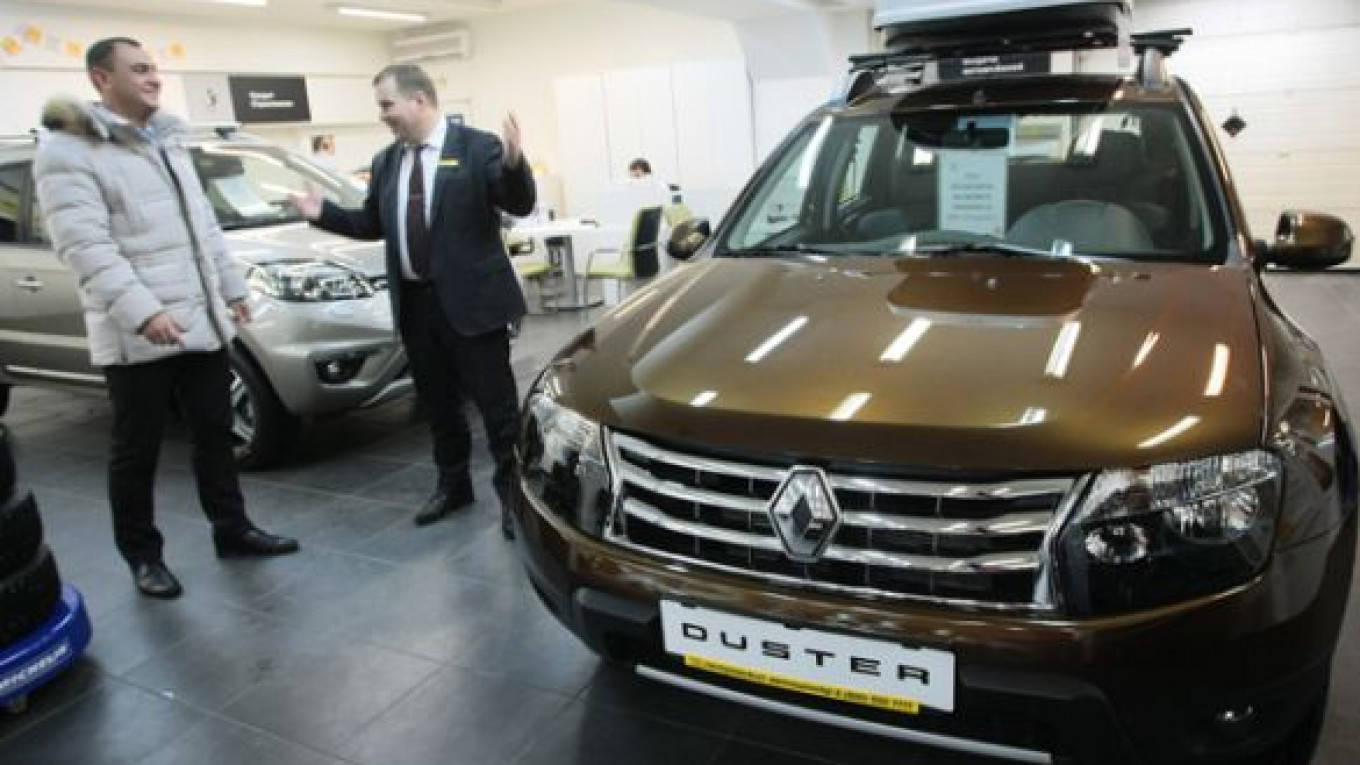Renault Russia sales chief Sergei Kuteishchikov had to shave his head last month, having lost what seemed a sure bet.
He gambled that in 2013's declining market, his dealers would beat the previous year's sales results, but not by much.
A recent message he sent to the dealers included a photograph of his nearly naked scalp.
"Everyone dreams of being a Renault salesman," said Gleb Krasnokutsky, a deputy director in charge of Renault at the Avtomir dealership at Dmitrovskoye Shosse.
As economic growth stuttered, sales of new passenger cars and light commercial vehicles contracted by 5 percent last year, according to the Association of European Businesses, which tracks the market. By contrast, Renault sales surged 11 percent.
The French carmaker rode high largely due to the success of its Duster model, a compact sport utility vehicle, or SUV, the company introduced in Russia in 2012. The car owes its popularity to a combination of off-road capabilities and a relatively modest price.
"We could have sold more of them," said Krasnokutsky. Avtomir ran short on the supply end last year, he said.
An average Duster sells for 600,000 rubles ($17,000) at the dealership, while Renault's most affordable model Logan, a sedan, will set you back 450,000 rubles.
Customer infatuation with the Duster also appears to be part of the recent trend of Russians' greater interest in SUVs, which offer prestige and protection from snow and bumpy roads.
Even on a recent slow weekday, a man walked into the dealership and took a close look at a Duster, lifting its hood and bending over.
Sales of Logans declined last year, despite an offer of interest-free loans on the purchase. But an updated Logan, expected later this year, could improve the picture.
At the other end of the pack, Ford sales dropped 18 percent last year, compared to 2012, because its performance largely rested on Focus sedans and hatchbacks — cars that had lost their appeal.
Its venture with Russian carmaker Sollers reduced production of those models at its plant in St. Petersburg earlier this year and began talks on cutting jobs. At the same time, the company bumped up output of SUVs, such as the Kuga and Explorer models, at its plant in Yelabuga, Tatarstan.
Svetlana Vinogradova, head of the Ford dealership at Rolf, explains why more drivers are buying sports utility vehicles.
Ford dealer Rolf said that its sales of the brand picked up 3 percent last year, compared to the previous year. One of the reasons, according to Svetlana Vinogradova, director of a Rolf's Ford dealership off Zvenigorodskoye Shosse, is the introduction of a plan that she described as a "free test drive for three years." The deal allows the customer to get an almost complete refund for the car after three years of use, she said.
"There is no such thing as a bad year," she said. "Everything is relative."
The deterioration of the market affected both domestic producers, including foreign manufacturers with local production lines, and imports. Domestic car production declined 1.8 percent last year, Deputy Prime Minister Arkady Dvorkovich said.
The drop might have been worse if it had not been for state intervention. The government in the year's second half introduced a subsidy on interest paid on car loans.
This year, the Cabinet has put aside a hefty amount for subsidies that will go directly to auto makers in a bid to support jobs. That notwithstanding, the country's biggest auto maker, AvtoVAZ, announced earlier this year it would lay off some of its staff in the coming months.
Carmakers will seek to support sale by focusing on the fastest-growing segments, such as compact SUVs, similar to Renault's last year's bestseller Duster.
But the companies will not turn their backs on low-cost vehicles, either. Among this year's expectations are Renault's Datsun and Skoda's Rapid.
What's more, the tried-and true recipes of expanding the dealer network and offering loans from in-house banks will also feature high on the list of measures to support sales.
The prospects remain far from rosy, however. The Association of European Businesses has predicted a further contraction of the market this year, albeit a slighter one, at 1 percent, than last year.
Here's a ranking of five brands, whose unit sales in Russia increased the most:
1. Renault sold 210,099 cars last year, which is 20,247 vehicles, or 11 percent more than in 2012.
The growth is not the steepest in terms of percentage points, where the record went to China's Geely, which was up 55 percent. But the increase certainly leaves others far behind if you look at the hard numbers.
The company attributed its strong performance largely to its new Duster model, whose popularity brought it to the top of the SUV segment last year, it said. In a bid to capitalize on the success, Renault at the end of last year unveiled a four-wheel drive Duster with an automatic transmission — an upgrade created especially for Russia.
Renault also aims to open outlets of its RN Bank, which it jointly created with Unicredit Bank recently, at all of its dealerships by the end of the year in a bid to offer loans to more customers.
2. Kia sold 198,018 cars last year, which is 10,688 vehicles, or 6 percent more than in 2012.
Going against market trends, it sold more of its Rio sedans and hatchbacks. Korean cars' lower prices in comparison to American and European brands is appealing to customers, given comparable quality, said Sergei Litvinenko, senior manager responsible for the auto market at PricewaterhouseCoopers.
3. China's Geely sold 27,263 cars last year, which is 9,697 vehicles, or 55 percent more than in 2012.
Chinese brands like Geely are some of the most affordable on the market because, being largely state-owned, they draw support from the state and tap a cheap workforce, Litvinenko said. In addition, their quality has considerably improved over just the past three years, he said.
Chinese automakers have 'seriously' expanded their dealer network last year, Litvinenko said. The dealers are still mostly small and medium-sized, but the growing sales give the Chinese more confidence to start talks with some of the major names on the market.
4. Mercedes-Benz sold 44,376 cars, which is 6,940 vehicles, or 19 percent more than in 2012.
The company offered a broader lineup of models in the luxury segment than some of its competitors, said spokesman Andrei Rodionov. The full-size SUV Mercedez GL class had no competitors on the market, he said.
One of the other hits, compact luxury sedan Mercedes-Benz CLA-Class, launched in January 2013, "showed insane sales growth," he said.
Its E class, a longtime sales leader, underwent a drastic restyling, including a new engine, driving interest in the model range.
5. Lifan, another Chinese car maker, sold 27,467 cars, which is 6,923 vehicles, or 34 percent more than in 2012.
Lifan is in the same position in terms of strategy and growth potential as Geely.
Here's a ranking of five brands, whose unit sales in Russia declined the most:
1. AvtoVAZ sold 456,309 cars, which is 81,316 cars, or 15 percent fewer than in 2012.
The country's largest carmaker said in a statement that the general economic situation and "pessimistic" forecasts were not helpful for sales.
In addition, the company had to reduce production of Lada Kalina and Lada Priora cars for a while as it prepared to start manufacturing their successors.
Many customers also delayed buying the new models because they waited for the cars to be available with fewer accessories.
AvtoVAZ blamed the decline on one more reason: It said suppliers were not ready last year to furnish a sufficient amount of components for the new models.
2. Chevrolet (part of GM Group) sold 174,649 cars, which is 30,393 vehicles, or 15 percent fewer than in 2012.
Inexpensive compact cars, like the ones that Chevrolet counted on for most revenues, took most of the blow from the market contraction, as demand shifted more toward SUVs, Litvinenko said.
In addition, premium brands began producing compact SUVs whose prices start at 900,000 rubles, presenting a challenge to some of the more expensive Chevrolet sedans and hatchbacks that sell for 700,000 rubles, he said.
3. Daewoo sold 60,829 cars, which is 27,403 vehicles, or 31 percent fewer than in 2012.
The company did not roll out an update of its bestselling Nexia model, which Litvinenko described as antiquated.
4. Ford sold 106,734 cars, which is 24,075 vehicles, or 18 percent fewer than in 2012.
Like Chevrolet, Ford experienced pressure from the shift in customer tastes to SUVs. In addition, its popular Focus model is not so new, but relatively expensive, Litvinenko said.
5. Skoda (part of Volkswagen Group) sold 87,456 cars, which is 11,606 vehicles, or 12 percent fewer than in 2012.
It is the least explicable fall, Litvinenko said, dubbing the brand's most popular model, the Octavia sedan, as a "good product at a good price."
Gleb Krasnokutsky, a deputy director in charge of Renault at the Avtomir dealership at Dmitrovskoye Shosse, said Octavia might put off some customers with its turbocharged engine, which requires more servicing.
Contact the author at [email protected]
A Message from The Moscow Times:
Dear readers,
We are facing unprecedented challenges. Russia's Prosecutor General's Office has designated The Moscow Times as an "undesirable" organization, criminalizing our work and putting our staff at risk of prosecution. This follows our earlier unjust labeling as a "foreign agent."
These actions are direct attempts to silence independent journalism in Russia. The authorities claim our work "discredits the decisions of the Russian leadership." We see things differently: we strive to provide accurate, unbiased reporting on Russia.
We, the journalists of The Moscow Times, refuse to be silenced. But to continue our work, we need your help.
Your support, no matter how small, makes a world of difference. If you can, please support us monthly starting from just $2. It's quick to set up, and every contribution makes a significant impact.
By supporting The Moscow Times, you're defending open, independent journalism in the face of repression. Thank you for standing with us.
Remind me later.






